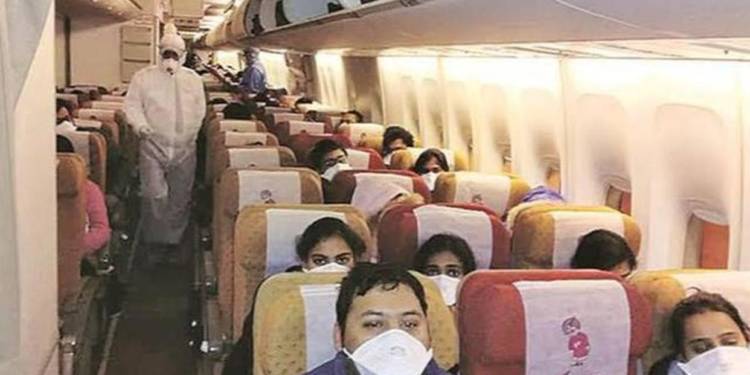The Coronavirus death toll is rising quickly even as the virus accounted for 108 deaths on February 10, the highest daily toll taking the total number of epidemic casualties beyond 1,000. In a difficult rescue operation, India managed to evacuate 647 Indians from quarantined areas of Wuhan, the epicentre of the Coronavirus outbreak.
According to a PTI report, report, Indian Ambassador to China, Vikram Misri has rightly described India’s evacuation of its patients from the Coronavirus-hit Hubei province and its capital, Wuhan as a “logistical nightmare”. The rescue operations had to be carried out in a region that was virtually in a state of complete lockdown.
Ever since the Coronavirus took a grip of China, the country has relied upon quarantines and lockdowns in order to check the spread of novel virus.
China has been continuously tightening the Wuhan lockdown. The Communist regime in the country has adopted severe methods like house to house searches, rounding up the sick (suspected Coronavirus-infected patients) and locking them up together in enormous quarantine centres.
China seems to have turned painstakingly utilitarian, as it is resorting to quarantining anyone who appears to be “sick” in virtual detention centres that offer minimal medical care. Such strong quarantine measures have fuelled a sense of abandonment and sacrifice of both the infected and the uninfected in an attempt to check the further spread of the Coronavirus.
China has locked down 45 million people, and while the utility of quarantines itself is in doubt that has clearly not stopped the Dragon from extreme measures. Disturbing videos and visuals from the affected region reveals the extent of extreme quarantine measures initiated by China.
China is said to have opened 11 quarantine centres, which are no less than virtual prisons and even military trenches have been dug near the quarantine centres in order to ensure that none of the inmates, including sick individuals and suspected Coronavirus carriers, are not allowed to escape.
There are also some disturbing videos of Chinese authorities, supposedly medical workers, forcing entire families into quarantine centres.
The visuals from Wuhan’s Fangcang Hospital that was supposedly built in a few days to cater to individuals manifesting mild to moderate symptoms are also disturbing. The patients have been kept in complete lack of isolation and medical equipment.
The quarantine centres seem to be nothing less than death camps, where suspected, infected and sick patients are all being warehoused together, putting even the lives of the uninfected at complete danger. It is in such conditions that the Indian Embassy evacuated the Indian citizens from the region.
https://twitter.com/jingli118/status/1225457409977507840
Militaries digging tranches near quarantine centers to prevent infected from escaping. #CoronaVirus #Wuhan
pic.twitter.com/nu0dChGZ3a— Coronavirus (@CoronaBeerus) February 6, 2020
https://twitter.com/htommy998/status/1225650230034481154
https://twitter.com/WBYeats1865/status/1225336979149090820
It was in such scenes of a virtual apocalypse in Wuhan and the Hubei province that the Indian authorities managed to evacuate the Indian citizens from quarantined localities.
According to Misri, India’s ambassador to China, the Indian Embassy had to first locate the Indian citizens stuck in Hubei, followed by taking their consent for a 14-day quarantine, before the most difficult part of the rescue operation, viz. taking the consent of China’s central, provincial and local governments, as Wuhan city and Hubei province were in a state of total lockdown since from January 23.
Despite travel bans and airborne Coronavirus, two diplomats from the Indian Embassy- Deepak Padma Kumar and M. Balakrishnan travelled to Wuhan by road, ahead of Air India’s first flight on February 1.
Another challenge came up before the Indian Embassy- transportation of Indian citizens to the airport amidst the apocalyptic atmosphere in the region.
Buses were hired and permits procured for areas that were under complete lockdown. Flight operations were halted in Wuhan with effect from January 23 besides all local transportation.
The Indian Embassy had to get permits to operate buses and to pick up Indians from 40 odd locations. The massive exercise was carried out by Acquino Vimal, the deputy ambassador, and Priyanka Sohoni, First Secretary (Political) in the Indian Embassy.
But travel bans were not the only issue, even roads had been dug up by the Chinese authorities in order to throw obstacles in the travelling of the quarantined residents of the Hubei province. The Indian Embassy had to oversee the evacuation operation from its control room that was hundreds of miles away.
Air India’s B747 aircraft made two flights to Hubei’s Capital city, Wuhan. 324 Indian citizens were evacuated in the first flight and 323 citizens besides seven Maldivians were evacuated in the second one.
80 Indian citizens are still stuck in Hubei. They are in contact with the Indian Embassy and the Indian mission is exploring options on how to evacuate the remaining citizens.
The manner in which the Indian Embassy managed to rescue its citizens from the horrifyingly quarantined locations of Hubei is nothing less than a miracle.


































